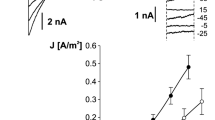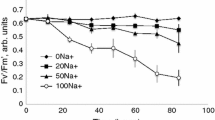Abstract.
The effects of elevated CO2 concentrations on stomatal movement, anion- and K+-channel activities were examined in guard cells from epidermal strips of Vicia faba. Membrane voltage was measured using intracellular, double-barrelled microelectrodes and ion-channel currents were recorded under voltage clamp during exposure to media equilibrated with ambient (350 μl · l−1), 1000 μl · l−1 and 10 000 μl · l−1 CO2 in 20% O2 and 80% N2. The addition of 1000 μl · l−1 CO2 to the bathing solution caused stomata to close with a halftime of approx. 40 min, and with 10 000 μl · l−1 CO2 closure occurred with a similar time course. Under voltage clamp, exposure to 1000 μl · l−1 and 10 000 μl · l−1 CO2 resulted in a rapid increase (mean, 1.5 ± 0.2-fold, n = 8; range 1.3- to 2.5-fold) in the magnitude of current carried by outward-rectifying K+ channels (IK,out). The effect of CO2 on IK,out was essentially complete within 30 s and was independent of clamp voltage, but was associated with 25–40% (mean, 30 ± 4%) decrease in the halftime for current activation. Exposure to CO2 also resulted in a four-fold increase in background current near the free-running membrane voltage, recorded as the instantaneous current at the start of depolarising and hyperpolarising voltage steps, and a decrease in the magnitude of current carried by inward-rectifying K+ channels (IK,in). The effect of CO2 on IK,in was generally slower than on IK,out; it was allied with a transient acceleration of its activation kinetics during the first 60–120 s of treatment; and it was associated with a negative shift in the voltage-sensitivity of gating over a period of 3–5 min. Measurements carried out to isolate the background currents attributable to anion channels (ICl), using tetraethylammonium chloride and CsCl, showed that CO2 also stimulated ICl and dramatically altered its relaxation kinetics. Within the timeframe of CO2 action at the membrane, no significant effect was observed on cytosolic pH, measured using the fluorescent dye 2′,7′-bis-(2-carboxyethyl)-5,6-carboxyflourescein (BCECF) and ratio fluorescence microphotometry. These results are broadly consistent with the pattern of guard-cell response to abscisic acid, and indicate that guard cells control both anion and K+ channels to achieve net solute loss in CO2. By contrast with the effects of abscisic acid, however, the data indicate that CO2 action is not mediated through changes in cytosolic pH and thereby implicate new and, as yet, unidentified pathway(s) for channel regulation in the guard cells.
Similar content being viewed by others
Author information
Authors and Affiliations
Additional information
Received: 8 January 1997 / Accepted: 28 February 1997
Rights and permissions
About this article
Cite this article
Brearley, J., Venis, M. & Blatt, M. The effect of elevated CO2 concentrations on K+ and anion channels of Vicia faba L. guard cells. Planta 203, 145–154 (1997). https://doi.org/10.1007/s004250050176
Issue Date:
DOI: https://doi.org/10.1007/s004250050176




